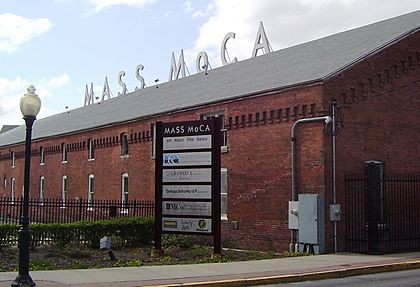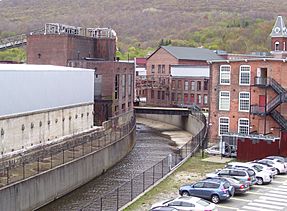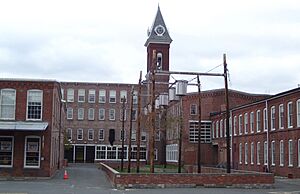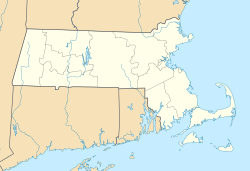Massachusetts Museum of Contemporary Art facts for kids
 |
|
| Established | 1999 |
|---|---|
| Location | North Adams, Massachusetts |
|
Arnold Print Works
|
|

Buildings of the Arnold Print Works, now MASS MoCA, along a tributary of the Hoosic River (2012)
|
|
| Location | 87 Marshall St., North Adams, Massachusetts |
|---|---|
| Area | 24 acres (9.7 ha) |
| Built | 1872 |
| Architectural style | Italianate Industrial |
| MPS | North Adams MRA |
| NRHP reference No. | 85003379 |
| Added to NRHP | October 25, 1985 |
The Massachusetts Museum of Contemporary Art, or MASS MoCA, is a huge art museum located in North Adams, Massachusetts. It's built inside old factory buildings. This museum is one of the biggest places in the United States for showing modern art and hosting live performances.
The buildings were first used by a company called Arnold Print Works from 1860 to 1942. After that, the Sprague Electric company used them. MASS MoCA first opened its doors in 1999. It had 19 galleries and about 100,000 square feet of space.
Since then, the museum has grown a lot. In 2008, they expanded Building 7. In May 2017, they added about 130,000 more square feet when Building 6 opened. Besides art galleries and performance areas, MASS MoCA also rents space to businesses.
It's also home to the Bang on a Can Summer Institute. Here, musicians and composers from all over the world come to create new music. This festival started in 2001 and includes concerts in the galleries. Since 2010, MASS MoCA has also hosted the Solid Sound Music Festival.
MASS MoCA is part of a group of important art museums in the northern Berkshires. The others are the Clark Art Institute and the Williams College Museum of Art.
Contents
- The Story of MASS MoCA's Buildings
- Amazing Art Exhibitions
- Current Exhibitions
- Past Exhibitions
- Invisible Cities
- Oh, Canada
- Katharina Grosse: One Floor Up More Highly
- Petah Coyne: Everything That Rises Must Converge
- Sean Foley: Ruse
- Jörg Immendorff: Student of Beuys, 6 paintings
- Jenny Holzer Projections
- Badlands: New Horizons in Landscape
- Simon Starling: The Nanjing Particles
- Iñigo Manglano-Ovalle: Gravity is a Force to be Reckoned With
- The Knitting Machine
- Material World: Sculpture to Environment
- Leonard Nimoy: Secret Selves
- Laylah Ali: Paintings on Paper
- Past Building 5 Exhibitors
- Museum Leaders
- See also
The Story of MASS MoCA's Buildings
From Print Works to Art Space
The buildings that are now MASS MoCA were built between 1870 and 1900. They were originally for a company called Arnold Print Works. Before that, smaller businesses had been on this spot for a long time. This location was special because it was on a piece of land between two branches of the Hoosic River.
In 1860, the Arnold brothers started their company here. They used the newest machines to print designs on cloth. They began working in 1862 and quickly became very successful. They even got big contracts from the government during the Civil War to make cloth for the Union Army.
In December 1871, a big fire destroyed eight of their buildings. But they started rebuilding right away. An even bigger factory complex was finished by 1874. Even though there was a tough economic time in the 1870s, Arnold Print Works kept buying land and building more. By 1900, almost all the buildings you see today were finished.
At its busiest in 1905, Arnold Print Works had over 3,000 workers. It was one of the world's top makers of printed fabrics. They produced an amazing 580,000 yards of cloth every week. That's about 330 miles! Arnold also had offices in New York City and Paris. They even started making their own plain, unfinished cloth, called "grey cloth," before printing on it.
In 1942, Arnold Print Works had to close down. This was because cloth from other places was cheaper. Also, the Great Depression had a big impact on the economy.
The Sprague Electric Era
After Arnold Print Works closed, the Sprague Electric Company bought the factory complex. This company was also from North Adams, Massachusetts. They started making capacitors, which are electronic parts. During World War II, Sprague worked all day and night. Many women worked there because men were away at war. Also, making small, hand-rolled capacitors needed small hands and careful work.
Besides making electronic parts, Sprague had a large research team. This team helped create parts for important projects. These included parts for the atomic bomb and for the launch systems of the Gemini space missions.
In the 1960s, Sprague was at its peak. It employed 4,137 workers in a town of 18,000 people. The factory was like a small city itself. Employees worked alongside their friends, neighbors, and family. The company even had its own radio station, orchestra, and a school for job training. It also had a research library, a daycare, a clinic, and a grocery store. There were sports teams and even a gun club on the campus.
In the 1980s, Sprague faced problems. Electronic parts from Asia became cheaper. Also, changes in high-tech electronics made things difficult. Sprague had to sell and close its factory in 1985. This left North Adams with many people out of work. The town faced a tough economic time.
The complex was added to the National Register of Historic Places in 1985.

How MASS MoCA Began
The idea for MASS MoCA started a year after Sprague Electric left the buildings. In 1986, some staff from the nearby Williams College Museum of Art were looking for a big space. They wanted to show large modern art pieces that wouldn't fit in their usual museum. The mayor of North Adams suggested the Marshall Street complex. When they saw the buildings, they realized the space had huge potential. That's when the plan for MASS MoCA truly began.
It took many years to raise money and organize the project. During this time, the idea grew. It became not just a museum but also a place for performing arts. A photographer named Nicholas Whitman documented this change in his book, Mass MoCA: From Mill to Museum.
The state of Commonwealth of Massachusetts gave the museum $18.6 million. This happened after local people and businesses asked the state government for help. Local residents and businesses also gave $8 million to the project. Finally, in 1999, MASS MoCA opened its doors to the public.
The Cambridge architecture firm Bruner Cott & Assoc designed the museum. They won top awards for their work. These awards came from the American Institute of Architects and The National Trust for Historic Preservation.
In 2015, a program called Assets for Artists started. It offers business coaching and studio space to artists and writers. This happens at the museum and at Maker's Mill. Maker's Mill is a shared workspace in downtown North Adams. It aims to bring back the kind of creative work that used to be part of the area's economy, like fiber arts and printing.
On May 29, 2017, Building 6 opened as new gallery space. This added about 130,000 square feet for exhibitions.
The museum is also featured in the 2018 documentary film Museum Town.
Amazing Art Exhibitions
Current Exhibitions
Sol LeWitt Wall Drawing Retrospective
On November 16, 2008, the museum opened a special exhibition of Sol LeWitt's wall drawings. This show is a partnership with Yale University Art Gallery and Williams College Museum of Art. The exhibition, called Sol LeWitt: A Wall Drawing Retrospective, fills a 27,000-square-foot building.
More than 100 huge wall drawings and paintings by the artist are on display. LeWitt created these works between 1968 and 2007. They will be on view until 2033. The historic mill building was changed by Bruner/Cott & Associates for this show. LeWitt planned where each drawing would go before he passed away in April 2007. A team of draftsmen installed the drawings from April to September 2008. Time Magazine called this exhibition the "top museum exhibition of 2008."
Anselm Kiefer's Installations
This exhibition is a partnership with the Hall Art Foundation. It features work by German painter and sculptor Anselm Kiefer. It includes three very large art pieces: Etroits Sont Les Vaisseaux, Les Femmes De La Revolution, and Velimir Chlebnikov. These works are in a 10,000-square-foot building that was specially updated for the show. You can see them during the spring, summer, and fall seasons until 2028.
James Turrell: Into the Light
Into the Light is a look back at many years of James Turrell's art. It's in B6: The Robert W. Wilson Building. This exhibition shows a major artwork from each decade of the artist's career.
Past Exhibitions
Invisible Cities
This exhibition was named after a book by Italo Calvino. It showed art by ten artists who imagined city landscapes. Some were familiar, and some were fantastical. Invisible Cities included works by Lee Bul, Carlos Garaicoa, and Sopheap Pich. It also featured new works made just for the show by Diana al-Hadid, Francesco Simeti, Miha Strukelj, and local artists Kim Faler and Mary Lum. (May 24, 2012 - February 3, 2013.)
Oh, Canada
"Oh, Canada" was the biggest show of modern Canadian art ever held outside of Canada. It featured art by more than 60 artists from every Canadian province and almost every territory. The artists were from different generations and used many types of art. (May 26, 2012 - April 8, 2013.)
Some of the artists who took part:
- Kim Adams
- Shuvinai Ashoona
- Rebecca Belmore
- Shary Boyle
- Bill Burns
- Eric Cameron
- Douglas Coupland
- Michel de Broin
- Marcel Dzama
- Michael Fernandes
- Sarah Anne Johnson
- Garry Neill Kennedy
- Wanda Koop
- Micah Lexier
- Kelly Mark
- Rita McKeough
- Chris Millar
- Kent Monkman
- Kim Morgan
- Annie Pootoogook
- Ned Pratt
- Michael Snow
- Charles Stankievech
- Hans Wendt
- Janet Werner
Katharina Grosse: One Floor Up More Highly
Katharina Grosse painted four large mounds of soil. They looked like they were spilling from an upper balcony into the huge gallery space below. Stacks of styrofoam pieces rose out of the colorful mounds. They matched the white walls of the gallery. (April 4, 2010 - January 1, 2012.)
Petah Coyne: Everything That Rises Must Converge
This exhibition showed art pieces in a fancy, old-fashioned style. They were in four galleries on MASS MoCA's main floor. One piece, "Scalapino/Nu Shu," looked like an old apple tree. Coyne had it moved to the museum after it stopped growing fruit. The exhibition also included some of her photographs. (May 29, 2010 - April 11, 2011.)
Sean Foley: Ruse
Sean Foley created a special artwork for MASS MoCA. It was on the wall outside the Hunter Center for the Performing Arts. This wall is over 100 feet long. (January 23, 2010 – December 31, 2011.)
Jörg Immendorff: Student of Beuys, 6 paintings
Jörg Immendorff was one of several famous artists who studied with Joseph Beuys. This was at the Düsseldorf Academy of Art. This exhibition was the second in a series of shows about Beuys and artists he influenced. (June 1, 2010 – February 26, 2012.)
Jenny Holzer Projections
On November 18, 2007, Jenny Holzer showed her first indoor projection in the United States. Holzer's projection at MASS MoCA filled a large room. First, it showed poems by Nobel laureate Wisława Szymborska. Later, it showed writings by Nobel laureate Elfriede Jelinek. (November 16, 2007 - November 16, 2008.) Other works by Holzer include twenty-one carved stone benches placed around MASS MoCA's campus. Some of her stone benches are still on long-term display in the Robert W. Wilson Building.
Badlands: New Horizons in Landscape
Badlands was an exhibition of environmental art. It explored how modern artists are interested in the Earth. It also showed their responses to environmental worries. New artworks were made for the exhibit by Vaughn Bell, the Center for Land Use Interpretation, Nina Katchadourian, Joseph Smolinski, and Mary Temple. Other artists included Robert Adams, the Boyle Family, Melissa Brown, Leila Daw, Gregory Euclide, J. Henry Fair, Mike Glier, Anthony Goicolea, Marine Hugonnier, Paul Jacobsen, Mitchell Joachim, Jane Marsching, Alexis Rockman, Edward Ruscha, Yutaka Sone, and Jennifer Steinkamp. (May 24, 2008 – April 12, 2009.)
Simon Starling: The Nanjing Particles
Simon Starling's The Nanjing Particles was based on a small 3D photograph. It showed a large group of Chinese workers in front of the Sampson Shoe Factory. Sampson had brought them from California to break a strike. This made it the largest group of Chinese workers east of the Mississippi River. Starling looked at the photograph under a special microscope. He could see the tiny metal particles that made up the picture. This inspired him to create two large sculptures. These were made by hand in Nanjing, China. (December 13, 2008 - November 1, 2009.)
Iñigo Manglano-Ovalle: Gravity is a Force to be Reckoned With
Iñigo Manglano-Ovalle's exhibition opened with an upside-down glass house. It was in MASS MoCA's large Building 5 gallery. The house's design came from plans by Mies van der Rohe for a house that was never built. A film called Always After (The Glass House) (2006) was shown with the house. (December 12, 2009 - October 31, 2010.)
The Knitting Machine
This was a sculpture by Dave Cole. He worked at MASS MoCA on this project. The Knitting Machine used two excavators fitted with huge 20-foot knitting needles. With these, they made an oversized American flag. When it was finished, it was folded into the traditional flag triangle. It was then displayed in a special case. Cole said the case was "slightly smaller than a Volkswagen Beetle". The 20-foot knitting needles and a video of the knitting process were also on display. (June 30, 2005 - December 31, 2005.)
Material World: Sculpture to Environment
This exhibition featured artists who used industrial materials. These included plastic sheeting and fishing line. Michael Beutler, Orly Genger, Tobias Putrih, Alyson Shotz, Dan Steinhilber, and collaborators Wade Kavanaugh and Stephen B. Nguyen created art. They used the old factory spaces on the museum's second and third floors. (April 24, 2010 - March 1, 2011.)
Leonard Nimoy: Secret Selves
Artist and actor Leonard Nimoy showed a recent series of photographs. He took pictures in nearby Northampton, Massachusetts. Nimoy asked volunteers from the community to pose as their true or imagined "secret selves." Along with the large, life-size photos, there was a video. It showed Nimoy talking with the people he photographed. (August 1, 2010 - January 2, 2011.)
Laylah Ali: Paintings on Paper
Paintings on Paper was an exhibition of small artworks on paper. These were made between 1996 and 1999 by the unique artist Laylah Ali. Ali's figures look like they are from a comic book. They have green heads and simple uniforms. They are shown in the middle of mysterious stories. At first, her "Greenheads" look colorful and inviting, like pictures from a comic strip or children's book. But if you look closer, the unsettling stories become clear. Ali, who is African-American, has created surreal figures. They seem to have gone through many cultural and racial changes. Ali's mysterious stories don't give many details. This means they can be linked to many different times in history around the world. They can also show what's happening now or what might happen in the future. (November 8, 2001 - January 28, 2002.) In 2006, Ali also showed her work figures on a field at MASS MoCA. This was a performance with Dean Moss. Ali is also a professor at nearby Williams College.
Past Building 5 Exhibitors
Many famous artists have shown their work in Building 5. These include Robert Rauschenberg, Tim Hawkinson, Robert Wilson, Ann Hamilton, Cai Guo-Qiang, Carsten Höller, Sanford Biggers, Xu Bing, and Ledelle Moe.
Museum Leaders
- 1999–2021: Joe Thompson
- 2021–present: Kristy Edmunds
See also




